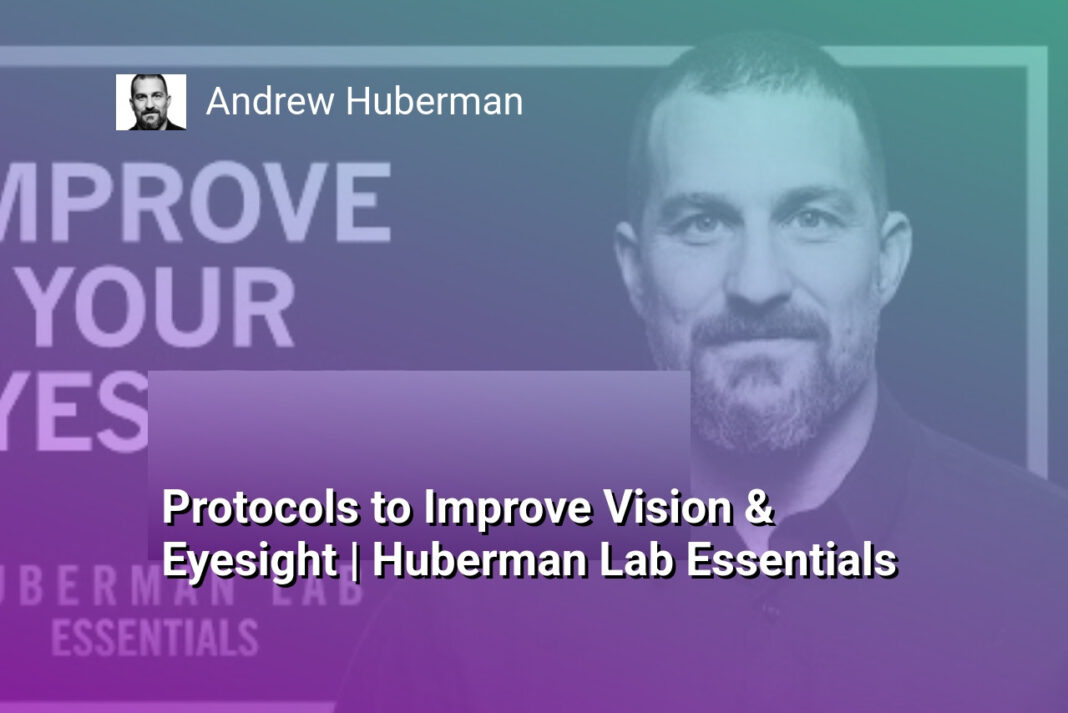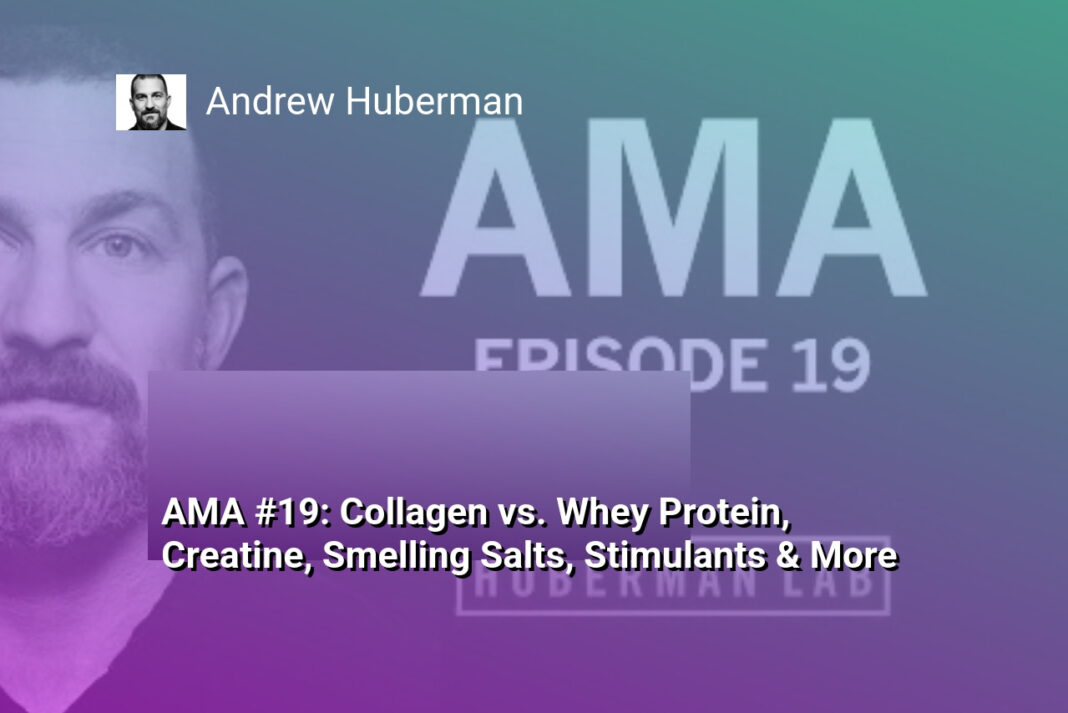The Bottom Line:
- I discovered that early morning sunlight exposure for 2-10 minutes can significantly regulate our circadian rhythm, enhancing mood and alertness through a natural biological mechanism.
- Our vision is far more complex than simply seeing, as it intricately connects with our central nervous system and influences multiple bodily functions beyond visual perception.
- Daily outdoor activities and long-distance viewing can dramatically improve eye health, reducing risks like myopia and maintaining lens flexibility and muscle strength.
- Implementing smooth pursuit eye exercises for a few minutes can substantially enhance visual coordination and tracking capabilities, contributing to overall eye performance.
- Nutrition plays a crucial role in maintaining eye health, with specific nutrients like vitamin A and lutein supporting vision and potentially mitigating age-related eye conditions.
Understanding the Science of Vision and Light Exposure
The Neurological Foundations of Visual Perception
Vision is a complex neurological process that extends far beyond simple image reception. The human eye functions as an intricate extension of the central nervous system, continuously processing and interpreting visual information through sophisticated neural networks. Photoreceptor cells in the retina convert light signals into electrical impulses, which are then transmitted through the optic nerve to the brain’s visual cortex for comprehensive interpretation and analysis.
Light’s Profound Impact on Physiological Functions
Exposure to natural light plays a critical role in regulating numerous bodily systems beyond visual perception. Sunlight triggers hormonal cascades that influence circadian rhythms, mood regulation, and metabolic processes. Specifically, morning light exposure stimulates the production of cortisol and suppresses melatonin, promoting wakefulness and alertness. By engaging in deliberate light exposure strategies, individuals can optimize their neurological and physiological performance.
Dynamic Visual Adaptation Mechanisms
The human visual system demonstrates remarkable adaptability through mechanisms like accommodation and smooth pursuit. The eye’s lens dynamically adjusts its curvature to focus on objects at varying distances, a process that requires continuous muscular engagement and neurological coordination. Regular practice of visual exercises can enhance lens flexibility, improve focusing capabilities, and maintain optimal visual acuity. Long-distance viewing and targeted eye movement practices contribute to maintaining the eye’s structural integrity and functional efficiency, potentially mitigating age-related vision deterioration.
Eye Exercises and Movement for Visual Performance
Dynamic Eye Movement Techniques
Eye tracking and movement exercises are critical for enhancing visual performance and neurological coordination. Smooth pursuit movements involve following a moving object with your eyes without turning your head, which helps improve eye muscle control and tracking precision. Practice these exercises by slowly moving a pen or finger horizontally, vertically, and diagonally while maintaining a steady gaze. These techniques strengthen the muscles responsible for visual tracking and can enhance overall eye coordination.
Focus and Accommodation Training
Accommodation training involves systematically challenging your eyes’ ability to shift focus between near and distant objects. Start by holding an object close to your face and gradually move it away while maintaining sharp visual clarity. Alternate between near and far objects every few seconds to stimulate the eye’s focusing muscles. This practice helps maintain lens flexibility and can potentially slow age-related vision deterioration. Regular accommodation exercises can improve concentration, reduce eye strain, and support better overall visual processing.
Peripheral Vision Enhancement
Developing peripheral vision awareness is crucial for comprehensive visual performance. Practice scanning techniques where you focus on a central point while simultaneously observing objects in your side vision. One effective method involves sitting in a comfortable position and maintaining a fixed central gaze while consciously noting movements or objects in your peripheral field. These exercises can improve spatial awareness, reaction times, and overall visual processing speed. Athletes, drivers, and individuals in high-demand visual environments can particularly benefit from consistent peripheral vision training.
Nutrition and Lifestyle Factors Impacting Eye Health
Dietary Foundations for Optimal Eye Function
Nutrition plays a critical role in maintaining and enhancing eye health. Consuming a diet rich in specific nutrients can significantly support visual performance and protect against age-related deterioration. Key nutrients like vitamin A, found abundantly in carrots, sweet potatoes, and spinach, are essential for retinal health and night vision. Omega-3 fatty acids, prevalent in fatty fish such as salmon and mackerel, contribute to maintaining the structural integrity of retinal cells and reducing inflammation. Antioxidants like lutein and zeaxanthin, found in leafy green vegetables and yellow fruits, help filter harmful high-energy light waves and protect the macula from potential damage.
Lifestyle Practices for Visual Wellness
Beyond nutrition, specific lifestyle practices can dramatically influence eye health and performance. Regular exposure to natural sunlight, particularly in the early morning, helps regulate circadian rhythms and supports overall visual function. Experts recommend spending at least two hours outdoors daily to reduce the risk of myopia and maintain lens elasticity. Incorporating targeted eye exercises like smooth pursuit movements and practicing long-distance viewing can enhance visual coordination and muscle strength. These practices not only improve eye tracking capabilities but also support the dynamic focusing abilities of the eye’s lens.
Holistic Approach to Eye Health Management
Comprehensive eye health extends beyond isolated interventions, requiring a holistic approach that integrates cardiovascular wellness, stress management, and consistent visual hygiene. Maintaining a healthy cardiovascular system ensures optimal blood flow to the retina, which is crucial for sustained visual performance. Regular vision screenings using tools like the Snellen chart can help track visual acuity and detect potential changes early. Additionally, managing screen time, practicing proper ergonomics, and ensuring adequate hydration contribute to reducing eye strain and supporting overall visual well-being. By adopting a multifaceted strategy that addresses nutritional, physical, and environmental factors, individuals can proactively optimize their eye health and visual performance.
Vision Development and Long-Term Maintenance Strategies
Holistic Approach to Vision Preservation
Maintaining optimal vision requires a comprehensive strategy that integrates multiple lifestyle and health considerations. The intricate relationship between overall bodily health and visual performance demands a multifaceted approach. Regular eye exercises, proper nutrition, and strategic environmental interactions play crucial roles in long-term vision maintenance. By understanding the complex neurological connections between the eyes and central nervous system, individuals can develop targeted interventions that support visual acuity and prevent potential degradation.
Strategic Lifestyle Modifications for Eye Health
Implementing deliberate daily practices can significantly impact vision quality and longevity. Exposure to natural sunlight for 2-10 minutes early in the day helps regulate circadian rhythms and supports overall visual system function. Long-distance viewing practices, such as intentionally focusing on objects half a mile away, help maintain lens elasticity and eye muscle strength. Smooth pursuit exercises, performed for 2-3 minutes daily, enhance eye tracking capabilities and visual coordination. These targeted interventions work synergistically to support the eye’s natural adaptive mechanisms and prevent potential deterioration.
Nutritional and Preventative Strategies
Nutritional support plays a critical role in vision maintenance and protection. Foods rich in vitamin A, lutein, and other essential nutrients provide foundational support for eye health. Cardiovascular fitness directly impacts visual performance by ensuring adequate blood flow to the retina. Regular monitoring using tools like the Snellen chart can help track vision performance over time, allowing for early detection of potential changes. Addressing binocular vision imbalances, particularly in children, prevents long-term vision complications. By combining targeted nutritional intake, strategic exercises, and comprehensive health monitoring, individuals can develop a robust approach to maintaining optimal visual performance throughout their lifetime.
Debunking Vision Myths and Promoting Holistic Eye Care
Separating Fact from Fiction in Eye Health
Numerous misconceptions about vision persist in popular culture, leading many individuals to adopt ineffective or potentially harmful practices. Contrary to widespread belief, eating carrots alone will not dramatically improve eyesight. While carrots contain vitamin A, which supports eye health, they are not a magical solution for vision enhancement. Similarly, the notion that reading in dim light permanently damages eyes is an exaggeration. While poor lighting can cause eye strain and temporary discomfort, it does not cause irreversible damage to vision.
The Holistic Approach to Visual Wellness
Optimal eye health requires a comprehensive strategy that extends beyond simple corrective measures. Vision is intricately connected to overall neurological function, involving complex processing within the central nervous system. Regular eye exercises, such as smooth pursuit movements and long-distance viewing, can help maintain lens elasticity and improve visual coordination. Incorporating practices like early morning sunlight exposure can regulate circadian rhythms and enhance overall visual performance.
Proactive Vision Management Strategies
Modern eye care emphasizes prevention and holistic wellness. Nutrition plays a crucial role, with specific nutrients supporting retinal health and potentially mitigating age-related vision decline. Cardiovascular health directly impacts eye function, as robust blood flow is essential for maintaining retinal integrity. Tracking vision performance using tools like Snellen charts can provide valuable insights into visual changes over time. Additionally, addressing binocular vision imbalances early, particularly in children, can prevent long-term visual complications and support comprehensive neurological development.





